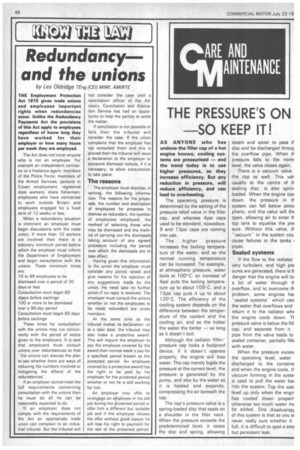gil ARE AND AINTENANCE
Page 78

If you've noticed an error in this article please click here to report it so we can fix it.
THE PRESSURE'S ON SO KEEP IT!
AS ANYONE who has undone the filler cap of a hot engine knows, cooling systems are pressurised — and the trend today is to use higher pressures, as they increase efficiency. But any reduction in pressure, will reduce efficiency, and can lead to overheating.
The operating pressure is determined by the setting of the pressure relief valve in the filler cap, and whereas 4psi caps used to be standard, nowadays, 9 and 13psi caps are coming into use.
The higher pressure increases the boiling temperature of the water, and so the normal running temperature can be increased. For example, at atmospheric pressure, water boils at 100°C; an increase of 4psi puts the boiling temperature up to about 105°C, and a 13psi cap puts it up to about 1200C. The efficiency of the cooling system depends on the difference between the temperature of the coolant and the cooling air, and so the hotter. the water the better — so long as it doesn't boil.
Although the radiator filler/ pressure cap looks a foolproof device, if it doesn't operate properly, the engine will lose water. The cap merely hojcls the pressure at the correct level; the pressure is generated by the pump, and also by the water as it is heated and expands, compressing the air beneath the cap.
The cap's pressure valve is a spring-loaded disc that seats on a shoulder in the filler neck. When the pressure exceeds the predetermined level, it raises the disc and spring, allowing
steam and water to pass It disc and be discharged throuc the overflow pipe. When it pressure falls to the norm level, the valve closes again.
There is a vacuum valve the cap as well. This vall usually at the centre of it sealing disc, is also sprin loaded. When the engine coo down, the pressure in tF system can fall below atmo phenc, and this valve will thE open, allowing air to enter top tank to equalise the pre sure Without this valve, tF "vacuum" in the system cou cause failures in the tanks 1 pipes.
Sealed systems If the flow to the radiator very turbulent, and high pre sures are generated, there is tl danger that the engine will a lot of water through tl overflow, and to overcome th problem, some engines ha -sealed systemswhich cat( the water that overflows and return it to the radiator whE the engine cools down. TI pressure valve is below the fill cap, and separate from it, pipe from the valve leads to sealed container, partially fillE with water.
When the pressure exceec the operating level, water discharged to the containe and when the engine cools, tF vacuum forming in the systel is used to pull the water bat into the system. Top the wati level up only when the engir has cooled down propeft otherwise too much water rnz be added. One disadvantac of this system is that as you a never really sure whether it full, it is difficult to spot a SME but persistent leak.
















































































































